![]()
![]()
![]()
Use LEFT and RIGHT arrow keys to navigate between flashcards;
Use UP and DOWN arrow keys to flip the card;
H to show hint;
A reads text to speech;
25 Cards in this Set
- Front
- Back
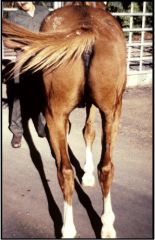
Horse with one hindflank smaller than other
Likely mechanism? 2 possible consequences? |

Denervation atrophy
Further reduction in mm mass Reinnervation |
|

Starved cow - name the condition
Outline the aetiopathogenesis (mm and fibres affected first?) |

Atrophy of cachexia
Insuff prot > catabolism of muscle protein > non-postural mm affected first, type 2 (fast) fibres affected first |
|
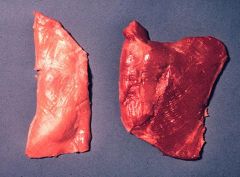
Collapsed cross-bred lamb. Hindlimb muscle on left (compared to normal or partially affected? on right)
Name the condition Outline the pathogenesis. |

White muscle D
VitE/Se deficiency > low antiox activity > free radical damage > lipid membrane peroxidation > incr Ca into myofibres > incr ATP used to remove Ca > mito damage, Ca-induced hypercontraction of myofibres > segmental degeneration > mineralisation of contractile proteins |
|
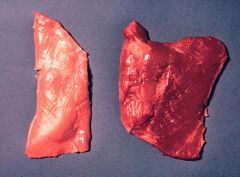
Collapsed lamb, affected muscle on left (normal on right).
Describe the typical appearance of muscles affected by WMD What other tissues are likely to be affected? |

Pale and flabby or wet, poor development of rigor +/- haemorrhagic streaks
Myocardium Lamb - left ventricular myocardial necrosis - shown |
|
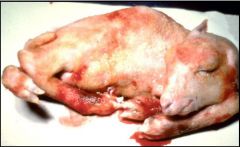
Lamb with twisted limbs
Name the condition Name a likely aetiological agent Briefly outline the pathogenesis |

Arthrogryposis
Akabane virus virus interferes with nerve development > inadequate foetal mm development > limb immobility > fibrosis of ligaments and contracture of tendons around joints |
|
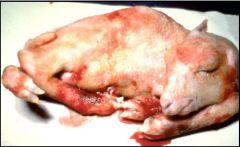
Lamb with arthrogryposis
List 4 potential causes |

Genetic defect
Teratogenic virus (Akabane) Teratogenic toxin (plant alkaloid) Nutritional def in mother (VitA, Mn) |
|
|
WMD
List 4 triggering factors |
Rapid growth
Unaccustomed exercise Cold weather Dietary (eg rancid fish oil) |
|
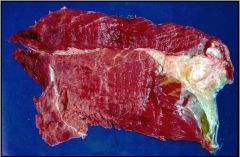
Horse, gluteal muscle post anaesthetic
Provide a likely pathogenesis |

Horse left on side for too long > ischaemia > coagulation of contractile proteins > inadequate repair dt damage to myofibre & satellite cells > necrosis
??? |
|
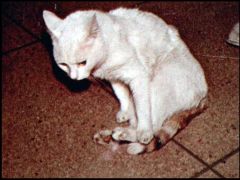
Old cat with paresis in both hindlimbs
Provide a plausible explanation |

Sorry it's a stretch!
Aortic thromboembolism > saddle embolism at terminal aorta bifurcation > ischaemia and infarction of hindlimb muscles |
|
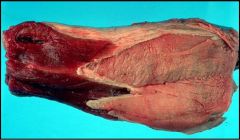
Pale soft wet skeletal muscle from a heavily muscled pig
Name the likely condition Outline the pathogenesis |

Porcine stress syndrome
Genetic defect in ryanodine receptor (Ca release channel of SR) > incr Ca in sarcoplasma > decr ATP (used to remove Ca) > switch to anaerobic glycolysis > generate heat & lactic acid > denature muscle proteins |
|

Blackened haemorrhagic muscle form an ox that died suddenly
Name the condition Name the aetiological agent |
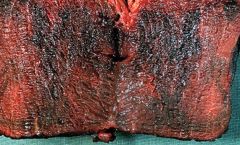
Blackleg
Clostridium chauvoei |
|
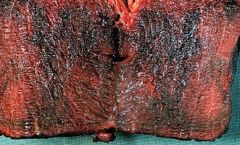
Blackleg from an ox
Outline the pathogenesis What other lesions are expected? |

C. chauvoei spores ingested > dormant in mm > muscle trauma > alkaline pH, low O2 > spores germinate > bacteria grow, toxin produced > muscle necrosis
Malignant oedema (of overlying subcutis and fascia) Fibrinohaemorrhagic pleuritis Fibrinohaemorrhagic endocarditis |
|
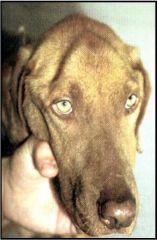
Dog with :"fox head" and inability to open/close jaws but remaining bright and alert
Name this condition Outline the pathogenesis |

Chronic stage of masticatory myositis
Auto-antibodies against myosin isotype found in masticatory muscles of adult dogs > CMI attack on muscle > acute: recurrent painful swelling, reluctant to eat > chronic: progressive severe bilat atrophy of masticatory mm |
|

Muscles with multiple small cream white foci.
Name the parasites involved |
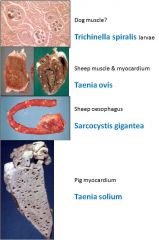
|
|
|
Name 2 protozoa that commonly cause myositis in domestic animals
|
Toxoplasma gondii
Neospora caninum (the tachyzoites) |
|
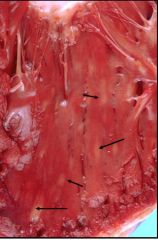
What would be your differential diagnostic list if you found multiple small cream white foci randomly scattered throughout the myocardium of an animal at necropsy?
|

Parasites that cause myocarditis
- Taeniid metacestodes - Sarcocystis spp - Trichinella spiralis/pseudospiralis (all > eosiniphilic myocarditis?) Virus - encephalomyocarditis virus infection in pigs (pic in slides) - canine HV, parvovirus Bacterial abscesses - Streptococcus spp. Lymphoma Fungal granuloma? |
|
|
List 10 possible causes of myocardial necrosis in domestic animals
|
Ischaemia
CNS lesions Trauma Stress Haemorrhagic shock VitE/ Se deficiency Toxic cps, eg 1080 Plant toxins eg cardiac glycosides in oleanders Metabolic disorder eg PSS, Malignant hyperthermia Renal failure (uraemic endocarditis) Phaeochromocytoma (incr Ad) |
|

Heart from a 2 mo old pig in excellent nutritional condition that died suddenly.
Likely disease? Other major gross lesions expected? |
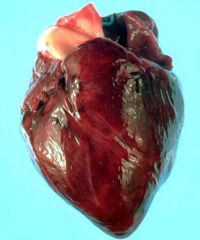
Mulberry heart disease dt VitE deficiency
See here diffuse epicardial haemorrhage. Other gross lesions could be; cyanosis of ears and ventral abdomen petechial haemorrhages hydropericardium orbital, palpelbral oedema pulmonary odema/ congestion ascites, hydrothorax, congested liver Anything referable to CHF really! |
|
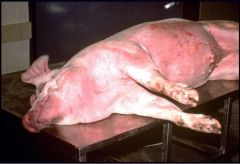
Pig after halothane exposure
Likely condition? Pathogenesis? |

Malignant hyperthermia
PSS -like syndrome induced by various drugs - deficit in SR Ca channels > myofibre hypercontraction > ATP consumption > anaerobic glycolysis > lactic acid, heat > coagulation of contractile proteins |
|
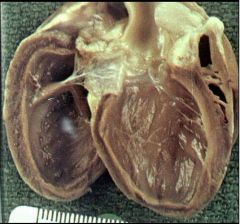
Cat opened heart left ventricle
Lesion? Brief pathogenesis? Likely sequelae? |

Left ventricular dilated myopathy
Volume overload (could be mitral valve insufficiency) Eccentric cardiac hypertrophy if volume overload sustained - CS referable to LS CHF |
|
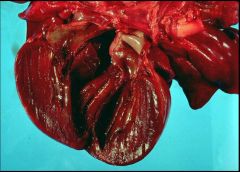
Opened cat heart at left ventricle
Lesion Brief pathogenesis Sequelae |

Concentric? cardiac hypertrophy
Sustained P overload CS referable to LS CHF |
|
|
What is a common consequence of cardiomyopathy in cats?
What CS would alert you to this problem? |
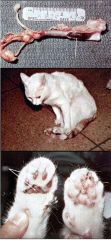
Arterial thromboembolism
Sudden onset hindlimb paresis No femoral pulse Cool limbs Cyanotic nailbeds |
|

German Shepherd - mass on right auricle
Likely diagnosis? Common sequelae? |
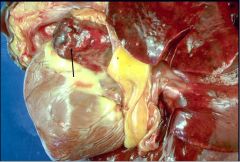
Haemangiosarcoma
Haemopericardium Metastasis to other organs esp lungs Predispose to DIC |
|
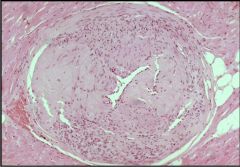
Dog coronary arteriole
Diagnosis Clinical significance |

Arteriolosclerosis
(no fatty deposition thus not atherosclerosis) Rarely of clinical significance, common age related change Infrequently may cause ischaemia |
|
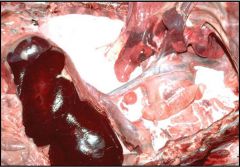
Opened dog thorax
Lesion name Pathogenesis Causes |

Chylothorax
Ruptured thoracic duct Thoracic trauma Severe coughing Neoplasia Dirofiliariasis Pleuritis CHF Inherited abnormalities of lymphatics |

